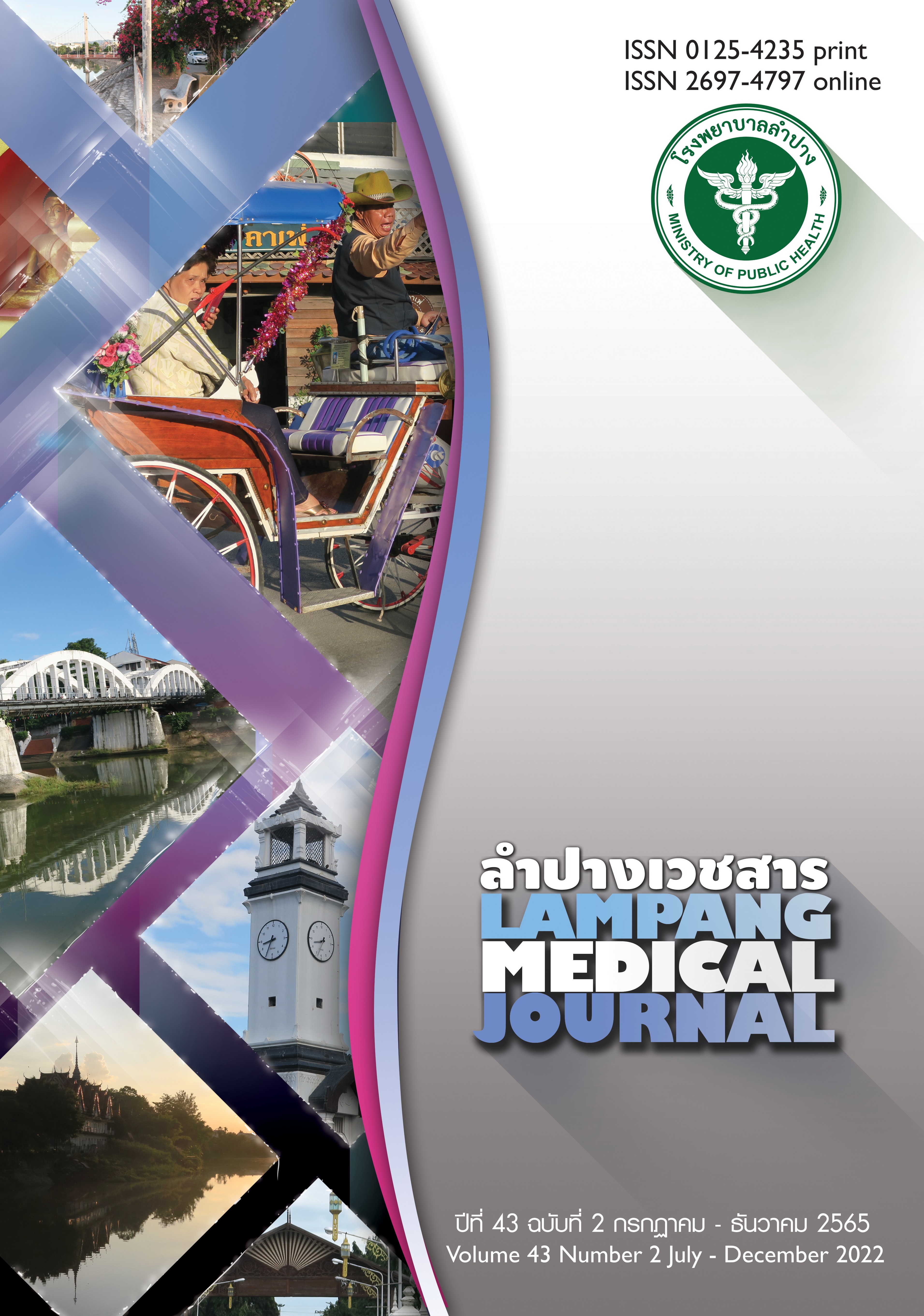Prevalence and Associated Factors of High-Grade Squamous Intraepithelial Lesion and Cervical Cancer among Patients with ASC-H Cervical Cytology and Follow-up Outcomes in Lampang Province
Main Article Content
Abstract
Background: In Thailand, the prevalence of high-grade squamous intraepithelial lesions (HSIL) and invasive cervical cancer among patients with atypical squamous cells cannot exclude high-grade squamous intraepithelial lesions (ASC-H). Cervical cytology varies widely from 26.3 to 69% and 4.5 to 20%,respectively. Information regarding the prevalence and associated factors in each particular area is thus important for planning appropriate management.
Objective: To determine the prevalence and risks of encountering HSIL and invasive cervical cancer among patients with ASC-H cervical cytology who underwent colposcopy in Lampang Hospital. Treatment outcomes were also assessed by the type of intervention received.
Material and method: From January 2009 to December 2018, 184 patients were included in this retrospective cohort study. Abstract data consisted of baseline clinical characteristics, most significant histologic results, types of treatment received, and the treatment outcomes during follow-up. Associated factors were assessed by using univariate regression analysis.
Results: Prevalence of HSIL and invasive cervical cancer were 35.3% and 6%, respectively. Only menopausal status was noted to be related to the risk of having underlying significant cervical lesion. Premenopausal patients were 2.4- times (95% CI 1.21-4.77) more likely to encounter with HSIL and invasive cancer compared to those in the postmenopausal group. Prevalence of high-grade squamous cervical smear or cancer abnormality during follow-up among 3 groups of patients who underwent follow-up alone, loop electrosurgical excision procedure, and hysterectomy were 2.6%, 2.6%, and 7.2% respectively.
Conclusion: The significant pathology results among patients with ASC-H smear in Lampang Hospital was 41.3 % and the associated factor was meno-pausal
Article Details

This work is licensed under a Creative Commons Attribution-NonCommercial-NoDerivatives 4.0 International License.
บทความที่ส่งมาลงพิมพ์ต้องไม่เคยพิมพ์หรือกำลังได้รับการพิจารณาตีพิมพ์ในวารสารอื่น เนื้อหาในบทความต้องเป็นผลงานของผู้นิพนธ์เอง ไม่ได้ลอกเลียนหรือตัดทอนจากบทความอื่น โดยไม่ได้รับอนุญาตหรือไม่ได้อ้างอิงอย่างเหมาะสม การแก้ไขหรือให้ข้อมูลเพิ่มเติมแก่กองบรรณาธิการ จะต้องเสร็จสิ้นเป็นที่เรียบร้อยก่อนจะได้รับพิจารณาตีพิมพ์ และบทความที่ตีพิมพ์แล้วเป็นสมบัติ ของลำปางเวชสาร
References
Sung H, Ferlay J, Siegel RL, Laversanne M, Soerjomataram I, Jemal A, et al. Global Cancer Statistics 2020: GLOBOCAN Estimates of Incidence and Mortality Worldwide for 36 Cancers in 185 Countries. CA Cancer J Clin. 2021;71(3):209–49.
Wilailak S, Lertchaipattanakul N. The epidemiologic status of gynecologic cancer in Thailand. J Gynecol Oncol. 2016;27(6):e65.
Nayar R, Wilbur DC. The Pap Test and Bethesda 2014. ‘The reports of my demise have been greatly exaggerated.’ (after a quotation from Mark Twain). Acta Cytol. 2015;59(2):121–32.
Marujo AT, Correia L, Brito M, Paula T, Borrego J. ASC-H cytological result: clinical relevance and accuracy of colposcopy in predicting high-grade histological lesions-a 7-year experience of a single institution in Portugal. J Am Soc Cytopathol. 2017;6(6):248–53.
Ortashi O, Abdalla D. Colposcopic and histological outcome of atypical squamous cells of undetermined significance and atypical squamous cell of undetermined significance cannot exclude high-grade in women screened for cervical cancer. Asian Pac J Cancer Prev. 2019;20(9):2579–82.
Nogara PR, Manfroni LA, Consolaro ME. Cervical cytology of atypical squamous cells cannot exclude high-grade squamous intraepithelial lesion (ASC-H): histological results and recurrence after a loop electrosurgical excision procedure. Arch Gynecol Obstet. 2011;284(4):965–71.
Kim SH, Lee JM, Yun HG, Park US, Hwang SU, Pyo JS, et al. Overall accuracy of cervical cytology and clinicopathological significance of LSIL cells in ASC-H cytology. Cytopathology. 2017;28(1):16–23.
Sherman ME, Castle PE, Solomon D. Cervical cytology of atypical squamous cells-cannot exclude high-grade squamous intraepithelial lesion (ASC-H): characteristics and histologic outcomes. Cancer. 2006;108(5):298–305.
Sari ME, Yalcin I, Sahin H, Meydanli MM, Gungor T. “Three-Step approach” versus “See-and-Treat procedure” in women with “high grade squamous intraepithelial lesion” (HSIL) or “atypical squamous cells cannot exclude HSIL” (ASC-H) cytology. Gynecol Obstet Reprod Med.
;24(3):151–5.
López-Alegría F, De Lorenzi DS, Quezada OP. Follow-up of women with atypical squamous cells cannot exclude high-grade squamous intraepithelial lesions (ASC-H). Sao Paulo Med J. 2014;132(1):15–22.
Barreth D, Schepansky A, Capstick V, Johnson G, Steed H, Faught W. Atypical squamous cellscannot exclude high-grade squamous intraepithelial lesion (ASC-H): a result not to be ignored. J Obstet Gynaecol Can. 2006;28(12):1095–8.
Ratree S, Kleebkaow P, Aue-Aungkul A, Temtanakitpaisan A, Chumworathayi B, Luanratanakorn S. Histopathology of women with “atypical squamous cells cannot exclude high-grade squamous intraepithelial lesion” (ASC-H) smears. Asian Pac J Cancer Prev. 2019;20(3):683–6.
Suntornlimsiri W. Outcome of the management of women with “atypical squamous cells” in cervical cytology after colposcopy. Thai J Obstet Gynaecol. 2008;16(4):227–36.
Kietpeerakool C, Srisomboon J, Tantipalakorn C, Suprasert P, Khunamornpong S, Nimmanhaeminda K, et al. Underlying pathology of women with ‘atypical squamous cells, cannot exclude high-grade squamous intraepithelial lesion’ smears, in a region with a high incidence of cervical cancer. J Obstet Gynaecol Res. 2008;34(2):204–9.
Sriplung H, Singkham P, Iamsirithaworn S, Jiraphongsa C, Bilheem S. Success of a cervical cancer screening program: trends in incidence in Songkhla, southern Thailand, 1989-2010, and prediction of future incidences to 2030. Asian Pac J Cancer Prev. 2014;15(22):10003–8.
Saad RS, Kanbour-Shakir A, Lu E, Modery J, Kanbour A. Cytomorphologic analysis and histological correlation of high-grade squamous intraepithelial lesions in postmenopausal women. Diagn Cytopathol. 2006;34(7):467–71.
Bulten J, de Wilde PC, Schijf C, van der Laak JA, Wienk S, Poddighe PJ, et al. Decreased expression of Ki-67 in atrophic cervical epithelium of post-menopausal women. J Pathol. 2000;190(5):545–53.
Qiao X, Bhuiya TA, Spitzer M. Differentiating high-grade cervical intraepithelial lesion from atrophy in postmenopausal women using Ki-67, cyclin E, and p16 immunohistochemical analysis. J low Genit Tract Dis. 2005;9(2):100-7


